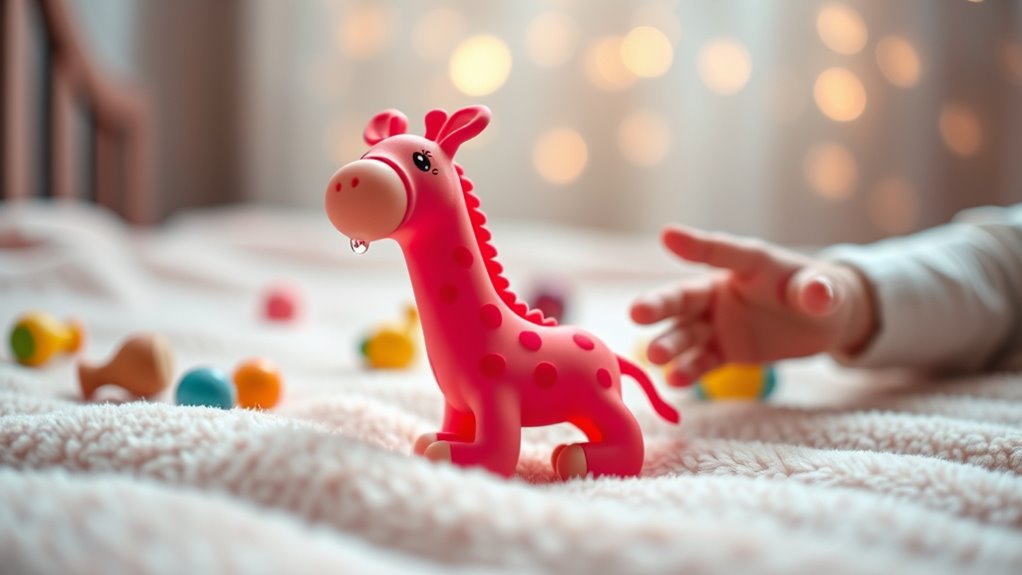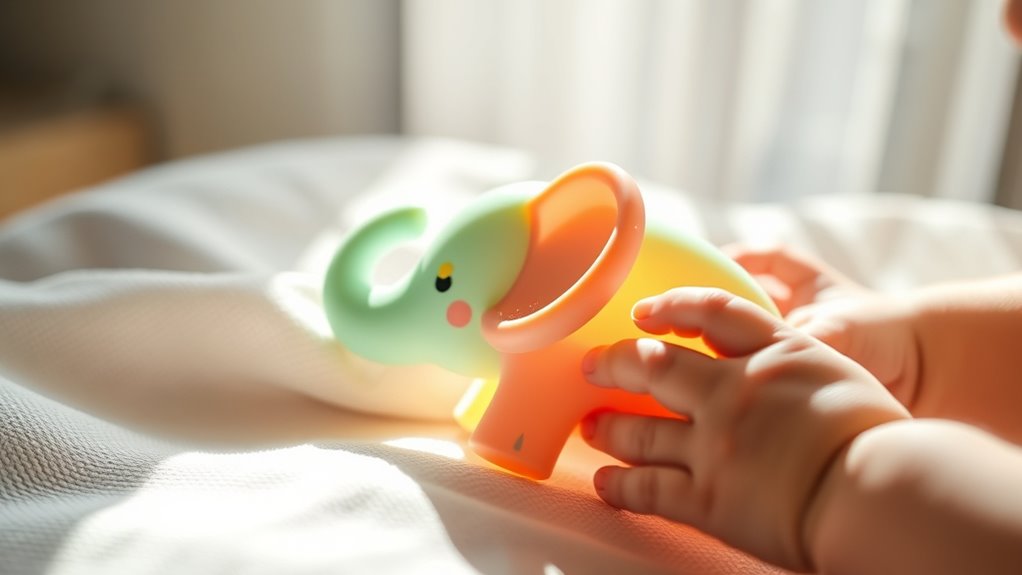To soothe your baby’s sore gums during teething, gently massage their gums with a clean finger in a circular motion. This can help reduce pain and promote better sleep. You can also use chilled teething rings or a damp washcloth for relief. Avoid frozen items that can be too harsh. Opt for safe silicone and rubber teething toys for your little one to chew on. There are even more tricks to help your baby through this tough time.
Key Takeaways
- Use a clean finger to gently massage the gums in a circular motion for pain relief.
- Chill teething rings or toys to soothe tender gums effectively without freezing them.
- Offer a cold, damp washcloth for the baby to chew on, providing a numbing effect.
- Provide silicone or rubber teething toys that are easy for the baby to grasp and safe.
- Consider chilled soft foods like applesauce or frozen breastmilk cubes for added comfort and relief.

Teething can be a challenging time for both you and your baby, but with the right strategies, you can ease their discomfort. As your little one’s teeth start to push through, you might notice some common symptoms, like drooling, irritability, and a strong desire to chew on objects. Their gums can become sore and tender, making this a tough phase for both of you. While low-grade fevers can occur, high fevers usually aren’t linked to teething, so keep an eye on other signs of discomfort.
Teething can be tough for both you and your baby, but there are effective strategies to ease their discomfort.
One effective trick is gentle gum massage. Using a clean finger, apply slight pressure to your baby’s gums in a circular motion. This not only helps reduce pain and swelling but can also relax your baby and promote better sleep. Just make sure to wash your hands thoroughly before starting the massage to keep everything hygienic.
Cold therapy can be a lifesaver during this time. Chilled teething rings or toys work wonders for soothing those tender gums. You can also use a cold, damp washcloth for a gentle numbing effect. However, avoid frozen items, as they can be too hard and cause more harm than good. Cool metal spoons can also be gently brushed against the gums, providing comfort. If your baby is ready for solids, chilled fruit like mashed bananas can offer relief while being delicious. Additionally, consider using amber necklaces that are popular among mothers for their potential to ease teething pain through the release of succinic acid.
When it comes to teething toys, stick to silicone or rubber options, as they’re safer. Avoid breakable plastic or metal toys, and steer clear of liquid-filled options that could leak. Choose toys that are easy for your baby to grasp, and give them a quick clean before refrigerating them for extra soothing relief.
If you’re open to natural remedies, amber necklaces are popular, believed to release succinic acid that may ease pain. You might also try making allspice teethers by boiling allspice and stringing them together. Frozen breastmilk cubes can be a delightful treat for your baby to chew on, while chilled soft foods like applesauce can soothe irritated gums.
If your baby seems particularly uncomfortable, you might consider acetaminophen or ibuprofen, but always consult your pediatrician first. Avoid benzocaine and homeopathic teething tablets, as they’re not recommended.
Remember to keep your baby hydrated, wipe away excess drool to prevent skin irritation, and maintain a consistent sleep routine to help them through this tough time.
Frequently Asked Questions
When Should I Start Using a Teether for My Baby?
You can start using a teether for your baby as early as 3 months, depending on their developmental stage and teething symptoms.
Look for signs like excessive drooling or chewing on objects. Teethers help develop oral motor skills and prepare them for solid foods.
Just ensure the teether is safe, made from non-toxic materials, and easy for your baby to grasp.
This early introduction can offer comfort and support their growth during this phase.
Are There Specific Materials to Avoid in Teethers?
When it comes to choosing a teether for your little one, you mightn’t realize the hidden dangers lurking in some materials.
Avoid products containing phthalates, BPA, or cadmium, as these can pose serious health risks. Keep an eye out for loose parts and steer clear of amber necklaces; they can lead to choking hazards.
Instead, opt for non-toxic options like food-grade silicone or wooden teethers coated in beeswax for peace of mind.
Can Teething Cause Fever in Babies?
Teething itself typically doesn’t cause a true fever in babies.
While you might notice a slight increase in temperature, it’s usually not above 100.4°F.
Most fevers during this period stem from other illnesses or infections, which can occur simultaneously.
Keep an eye on your baby’s overall health; if their temperature exceeds that mark or you observe other concerning symptoms, it’s best to consult a healthcare professional to rule out any issues.
How Often Should I Clean My Baby’s Teether?
When it comes to your little one’s teething companion, maintaining a pristine environment is essential.
You should clean your baby’s teether daily, especially after each use, to ward off any unwanted bacteria. For frequently used toys, consider washing them after every use.
As your child grows, you can ease up a bit, cleaning every two to three days.
Always clean immediately if it’s fallen on the floor or come in contact with pets!
What Are Signs My Baby Needs a Teether?
When your baby needs a teether, you’ll notice some specific signs.
Look for red, swollen gums and increased drooling. Your little one might start chewing on hard objects or show a loss of appetite.
Restlessness or crankiness can also indicate they’re uncomfortable.
Keep an eye on these symptoms, as they can help you determine when it’s time to introduce a teether to soothe their gums and ease their discomfort.
Conclusion
Incorporating the teether trick into your routine can really soothe your little one’s gums. Remember, “patience is a virtue”—it may take a bit of trial and error to find the right teething solution for your baby. Stay consistent, and soon enough, you’ll discover what brings them relief. Keep an eye on their comfort levels, and don’t hesitate to consult your pediatrician if you have concerns. Happy teething!









